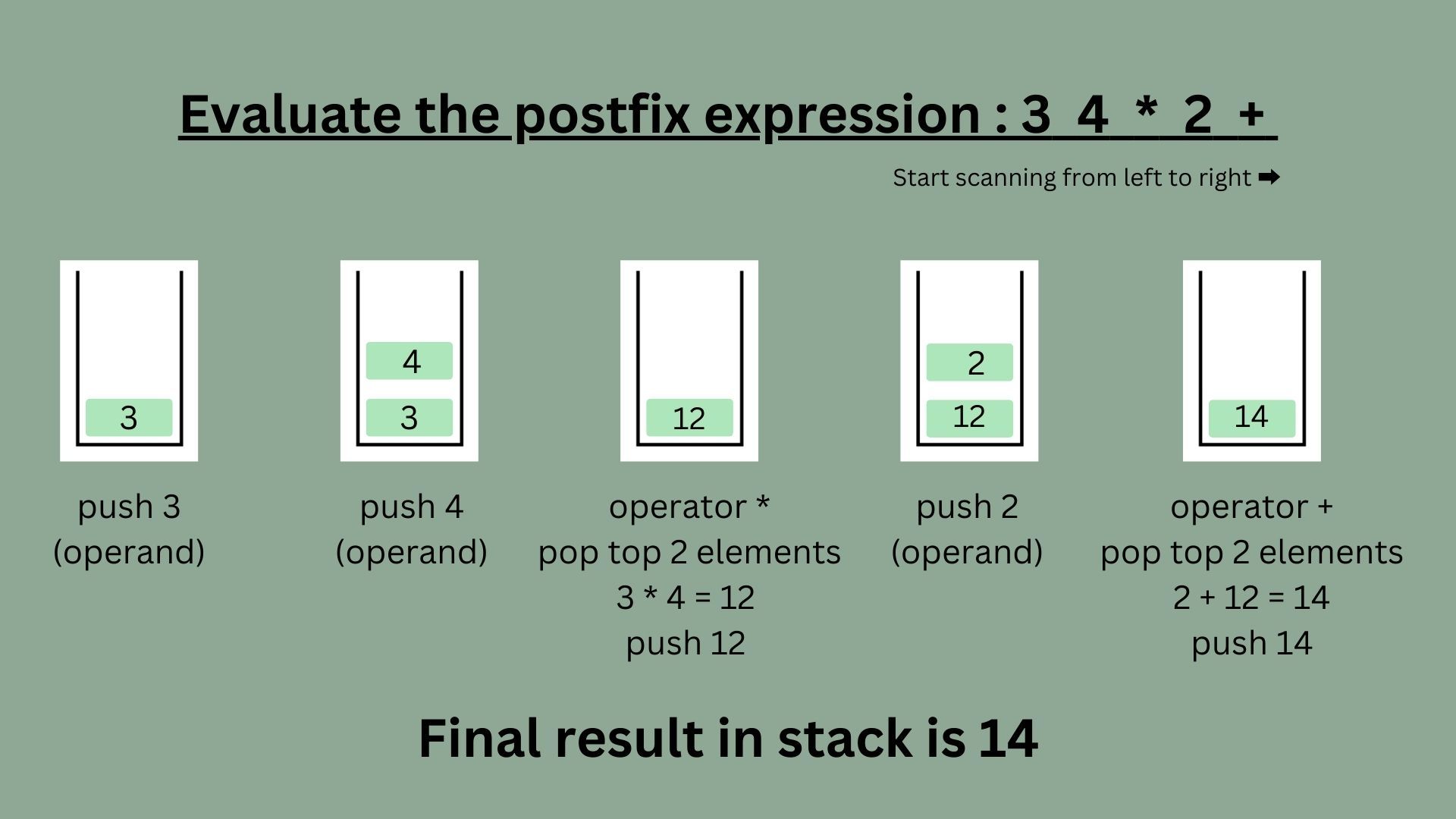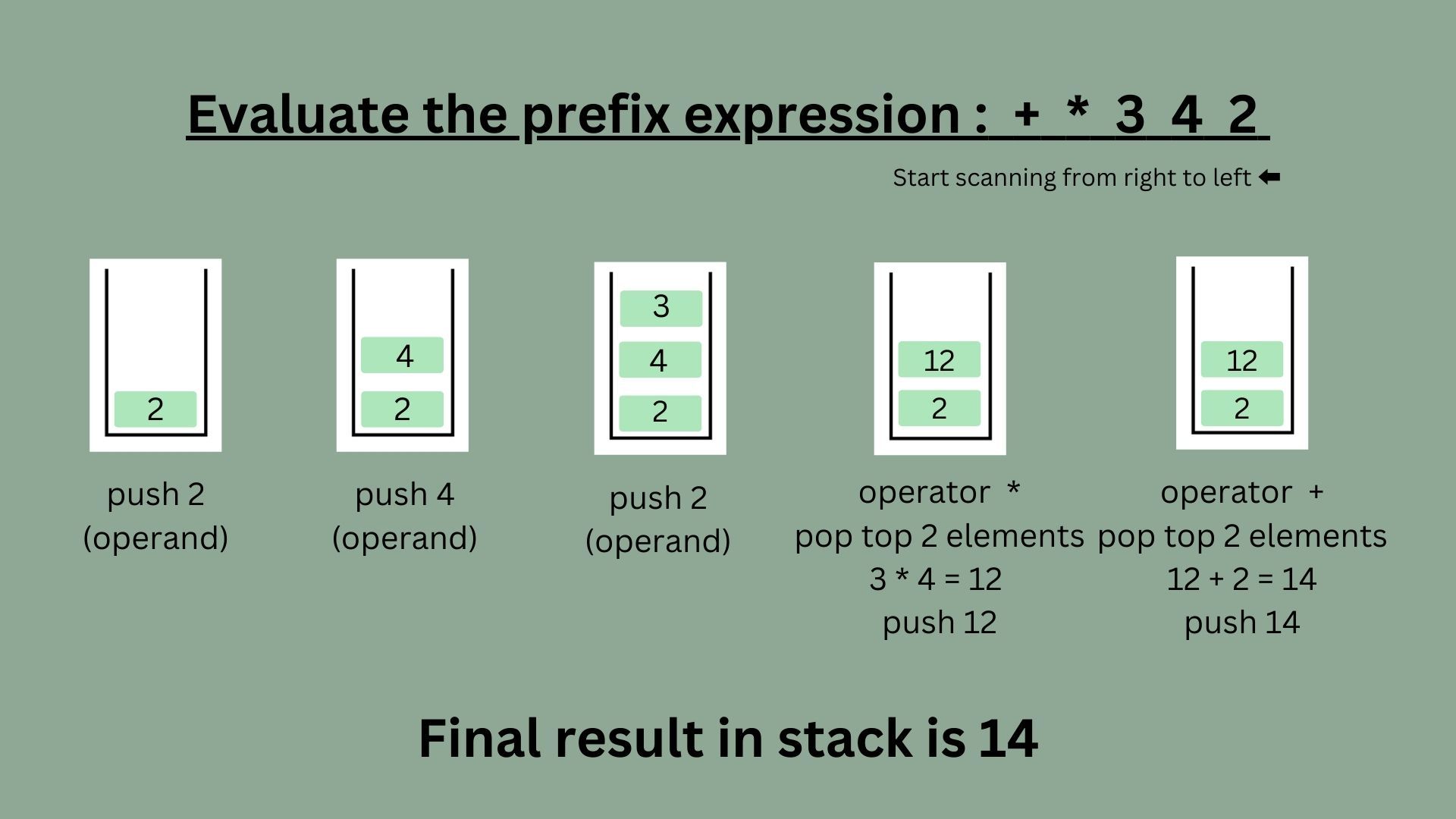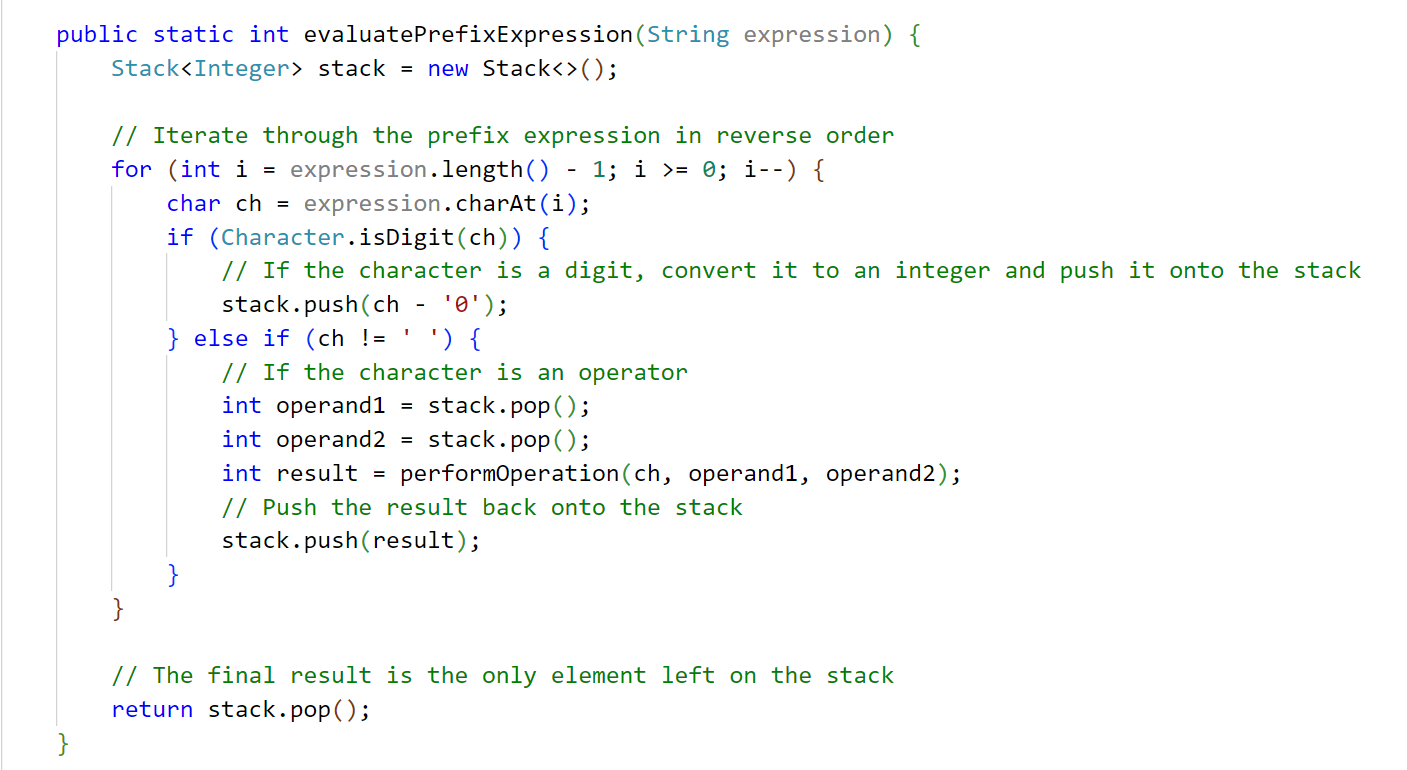Introduction
In the realm of computer science and mathematics, expressions play a fundamental role.
These expressions can be written in various notations, each with its unique set of rules and complexities.
Evaluating these expressions, especially in Prefix, Infix, and Postfix notations, can be puzzling. However, the power of stacks comes to the rescue, offering elegant solutions to these problems.
In this blog, we will delve into the knowledge of these notations and explore how stacks provide a methodical approach to evaluating expressions.
Understanding the Notations: Prefix, Infix, and Postfix
- Infix Notation: This is the standard mathematical notation where operators are placed between operands, and parentheses are used to indicate the order of operations. For example,
3 + 4 * (2 - 1)is an infix expression. - Prefix Notation (Polish Notation): In this notation, operators precede their operands. For instance, the infix expression
3 + 4 * (2 - 1)is represented as+ 3 * - 2 1 4. - Postfix Notation (Reverse Polish Notation): Here, operators come after their operands. Using the same example, the postfix notation of
3 + 4 * (2 - 1)is3 2 1 - * 4 +.
Evaluating Expressions Using Stacks: A Systematic Approach
1. Evaluating Postfix Expressions:
To evaluate a postfix expression, you can use a stack data structure.
→ Start scanning the expression from left to right.
→ If you encounter an operand, push it onto the stack.
→ If you encounter an operator, pop the required number of operands from the stack, perform the operation, and push the result back onto the stack.
→ After scanning the entire expression, the final result should be the only element left on the stack.
Consider the postfix expression: 3 4 * 2 +.
A. Initialize an Empty Stack:
Start by initializing an empty stack.
B. Iterate through the Expression:
- Begin iterating through the postfix expression from left to right:
3 4 * 2 +. - When
3is encountered, it's an operand, so push it onto the stack: Stack:[3]. - Move to
4, another operand, and push it onto the stack: Stack:[3, 4]. - Next, encounter
*, which is an operator. According to the postfix notation rules, an operator requires two operands. - Pop the top two elements from the stack, perform the multiplication operation (
3 * 4 = 12), and push the result back onto the stack: Stack:[12]. - Continue to
2, an operand, and push it onto the stack: Stack:[12, 2]. - Finally, encounter
+, which is an operator. Pop the top two elements from the stack, perform the addition operation (12 + 2 = 14), and push the result back onto the stack: Stack:[14].

C. Final Result:
- After iterating through the entire postfix expression, the final result left on the stack (
14in this case) is the output of the expression.
Explanation: The postfix expression 3 4 * 2 + is equivalent to the infix expression (3 * 4) + 2. By following the postfix evaluation algorithm step by step, we successfully computed the expression's result using a stack.
This method is highly efficient and allows for easy evaluation of mathematical expressions without the need for parentheses or a specific order of operations. Postfix notation, in particular, is often used in calculators and programming languages due to its simplicity and ease of evaluation.
I hope this detailed example clarifies the process of evaluating postfix expressions using a stack!
The function (code) for evaluating postfix expression :

You also have to prepare the "performOperation" method for the calculation/operations between two operands.
Here's the code snippet for the same

End of Postfix Expression Evaluation
2. Evaluating Prefix Expressions:
Prefix notation, also known as Polish Notation, is a mathematical notation where every operator follows all of its operands. Unlike infix notation, prefix notation eliminates the need for parentheses and defines a clear order of operations. Using stacks, we can efficiently evaluate prefix expressions, making it a fundamental concept in computer science and mathematics.
To evaluate a prefix expression, you can use a stack data structure.
→ Start scanning the expression from right to left.
→ If you encounter an operand, push it onto the stack.
→ If you encounter an operator, pop the required number of operands from the stack, perform the operation, and push the result back onto the stack.
→ After scanning the entire expression, the final result should be the only element left on the stack. Consider the prefix expression: + * 3 4 2.
Consider the prefix expression: + * 3 4 2.
A. Initialize an Empty Stack:
- Start by initializing an empty stack.
B. Iterate through the Expression:
- Begin iterating through the prefix expression in reverse order:
+ * 3 4 2. - When
2is encountered, it's an operand, so push it onto the stack: Stack:[2]. - Move to
4, another operand, and push it onto the stack: Stack:[2, 4]. - Next, encounter
3, which is an operand, and push it onto the stack: Stack:[2, 4, 3]. - Encounter
*, which is an operator. According to the prefix notation rules, an operator requires two operands. - Pop the top two elements from the stack, perform the multiplication operation (
3 * 4 = 12), and push the result back onto the stack: Stack:[2, 12]. - Finally, encounter
+, which is an operator. Pop the top two elements from the stack, perform the addition operation (12 + 2 = 14), and push the result back onto the stack: Stack:[14].

C. Final Result:
- After iterating through the entire prefix expression, the final result left on the stack (
14in this case) is the output of the expression.
Explanation: The prefix expression + * 3 4 2 is equivalent to the infix expression (3 * 4) + 2. By following the prefix evaluation algorithm step by step, we successfully computed the expression's result using a stack.
This method is highly efficient and allows for easy evaluation of mathematical expressions without the need for parentheses or a specific order of operations. Prefix notation, often used in programming languages and calculators, is an essential concept in computer science.
The function (code) for evaluating prefix expression :

You also have to prepare the "performOperation" method for the calculation/operations between two operands. (Discussed earlier)
End of Prefix Expression Evaluation
3. Evaluating Infix Expressions:
Infix notation is the standard mathematical notation where operators are placed between operands, and parentheses are used to indicate the order of operations. Mastering the evaluation of infix expressions is crucial in computer science and mathematics. By utilizing stacks, we can elegantly handle infix expressions, making complex calculations more manageable and efficient.
To evaluate an infix expression, you can use a stack data structure.
→ Start scanning the postfix expression from left to right.
→ If you encounter an operand, push it onto the stack.
→ If you encounter an operator, pop the required number of operands from the stack, perform the operation, and push the result back onto the stack.
→ After scanning the entire expression, the final result should be the only element left on the stack.
Consider the infix expression: (3 * 4) + 2.
A. Initialize an Empty Stack and Output Queue:
- Start by initializing an empty stack and an empty output queue.
B. Iterate through the Expression:
- Begin iterating through the infix expression:
(3 * 4) + 2. - When
(is encountered, push it onto the stack: Stack:[(]. - Move to
3, an operand, and add it to the output queue. - Encounter
*, push it onto the stack: Stack:[(, *]. - Move to
4, an operand, and add it to the output queue. - Encounter
). Pop operators from the stack and add them to the output queue until(is encountered. Stack:[(], Output Queue:[3, 4, *]. - Encounter
+, push it onto the stack: Stack:[(, +]. - Move to
2, an operand, and add it to the output queue.
C. Final Result:
- After iterating through the entire infix expression, the output queue (
[3, 4, *, 2, +]) represents the expression in Reverse Polish Notation (postfix notation). - Use a stack to evaluate the postfix expression:
3 4 * 2 +. Follow the postfix evaluation algorithm to compute the result (14in this case).
Explanation: By transforming the infix expression into postfix notation using stacks, we simplify the evaluation process. The postfix notation, in turn, enables us to efficiently compute the final result using a stack-based approach.
This methodical approach allows us to handle complex infix expressions with ease, making it a valuable tool in algorithm design and mathematical problem-solving.
End of Infix Expression Evaluation
Certainly! Understanding the concepts of evaluating prefix, postfix, and infix expressions using stacks is fundamental in computer science and programming. These concepts are widely used in various algorithms and data structures. Feel free to share this information with others to help them grasp these essential concepts. If you have any more questions or need further assistance, please don't hesitate to ask. Thank you for your interest!🙌

